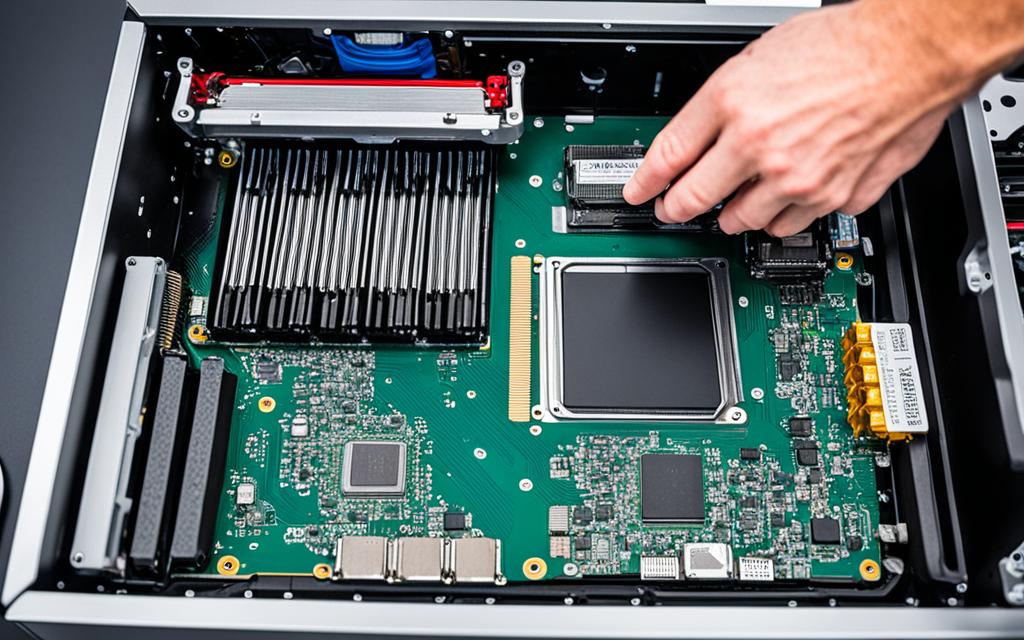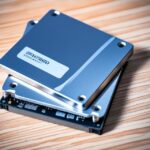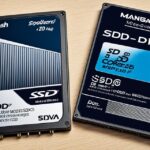Table of Contents
Putting Windows on an SSD makes your computer work faster. It speeds up starting and running programs. This SSD installation guide will help you set it up right. You will learn to prepare, create installation media, and fix any problems. It’s made for beginners and those who already know a bit. By installing Windows on an SSD the right way, your computer will respond better and faster.
Key Takeaways
- SSDs are a lot quicker than HDDs because they use flash memory.
- More laptop users are choosing to install Windows on SSDs for better speed.
- It’s important to have at least an 8GB USB flash drive for installing Windows 10.
- Getting your SSD ready and properly connected is a key part of the process.
- During installation, common errors can happen with partition styles, so compatibility is key.
Why You Should Install Windows on an SSD
Switching to an SSD for Windows offers great benefits. One major plus is faster read and write speeds. This makes everything on your computer speed up.
Benefits of SSDs Over Traditional Hard Drives
With an SSD, Windows starts in seconds, much quicker than with HDDs. This speed makes using your computer faster and more efficient. Also, SSDs can last around 20 years, much longer than HDDs3. They use less power and are quieter too.
Performance Enhancements Including Boot Times and Application Launches
SSDs can be a hundred times faster than HDDs in some tasks4. They make programs start quicker and files move faster. The smaller, quicker M.2 SSDs offer even faster speeds and ease of use3. This is a big help for those who need their computer to work quickly.
Durability and Energy Efficiency
SSDs are tougher because they have no moving parts. They’re less likely to break if dropped. They also use less power, which is great for laptops. This means longer battery life and a better experience.
System Requirements for Installing Windows on an SSD
Before you add Windows to an SSD, make sure your system is up to the task. You’ll need to meet the critical Windows 10 system requirements and Windows 11 requirements. For Windows 10, this includes at least a 1 GHz processor. You also need 1 GB of RAM for 32-bit versions and 2 GB for 64-bit, plus a minimum of 16 GB of storage (20 GB for 64-bit).
Windows 11 asks for a 64-bit processor that has at least 1 GHz with two cores, 4 GB of RAM, and 64 GB of storage, for things to run smoothly. Upgrading to a Windows setup on an SSD can really speed things up. A lot of users have moved to SSDs to enjoy faster and more reliable performance5.
Windows 10 and 11 Basic Requirements
It’s crucial to understand the Windows 10 system requirements and Windows 11 requirements for SSD installation. Matching your hardware with these requirements ensures a smooth upgrade. Check your hardware against these needs before you start, to dodge installation problems.
Understanding SSD Partition Styles: MBR vs GPT
The SSD partition styles are key in organizing data, affecting both performance and capacity. You have MBR (Master Boot Record) and GPT (GUID Partition Table) to choose from. MBR fits older systems with BIOS firmware and works with drives up to 2 TB. GPT, on the other hand, supports larger drives and is needed for UEFI systems. When setting up a new SSD, pick the right style to match your operating system’s installation needs6.
| Requirement | Windows 10 | Windows 11 |
|---|---|---|
| Processor | 1 GHz, 1 core | 1 GHz, 2 cores, 64-bit |
| RAM | 1 GB (32-bit), 2 GB (64-bit) | 4 GB |
| Storage | 16 GB (32-bit), 20 GB (64-bit) | 64 GB |
| Partition Style | MBR/GPT Compatible | GPT Required for UEFI |
Preparing Your Computer for Windows Installation
Getting your computer ready for Windows involves a few key actions. You must back up all important data first. This makes sure you don’t lose any crucial files. Adding an SSD, instead of an older hard disk, can really speed up your computer. Making these preparations is worth it in the end7.
Back Up Important Data Before Installation
Before you start swapping drives, backing up your data is essential. Keep your files safe using an external drive or cloud storage. This way, you won’t worry about losing anything important. Failing to back up could mean losing data forever. So, make sure you do this first.
How to Properly Connect Your SSD
After saving your data, it’s time to hook up the SSD. Make sure to use the right SATA cable or M.2 slot for your SSD. Check the connections are tight to avoid problems. Most new computers already have an SSD, which simplifies this step7.
Initialising Your SSD for Windows Installation
Before installing Windows, you must initialise your SSD. You’ll need to format it and choose a partition style – MBR or GPT. Windows Disk Management can help with this task. Properly setting up your SSD ensures it works well, ready for a smooth installation8 and7.
Creating Windows Installation Media
Creating installation media is a key step for putting Windows on an SSD. The Microsoft Media Creation Tool helps with downloading the Windows OS. It also helps in moving it to a USB or DVD. It’s best to use a USB drive with at least 8 GB of space. This ensures there’s enough room for all files needed.
Using Microsoft’s Media Creation Tool
The process of creating Windows installation media is made easy with the Microsoft Media Creation Tool. This tool handles file downloads and checks if your PC can run the upgrade. You can choose to keep your files and apps, just personal files, or start fresh by removing everything. This tool is quite handy, especially if the usual Windows Update method causes problems9.
Choosing Between USB and DVD Installation Media
When making installation media, you can pick between using a USB flash drive or a DVD. The USB option is often preferred for its ease and reliability. However, a DVD might be better for those with older computers that can boot from a DVD drive. Both methods work well with the Microsoft Media Creation Tool, making installation smooth10.
| Media Type | Advantages | Disadvantages |
|---|---|---|
| USB Installation | Fast booting; easy to reuse; compact design | Requires USB port; can be lost easily |
| DVD Installation | Compatible with older systems; easily shareable | Slower installation; limited write cycles |
For more information on this topic, you can find further insights here910.
Steps to Install Windows onto an SSD
Starting to install Windows on an SSD might seem hard, but it’s quite doable with the right steps. By following them correctly, you can install Windows completely. This will boost your system’s work and dependability a lot.
Starting the Installation Process
First, power up your computer using the installation USB drive or a DVD. Go into the BIOS settings to choose the boot order. Make the media top priority. When the media loads, pick your language and move on to install.
Studies suggest the best way to put Windows on an SSD without USB is a clean install11.
Choosing the Right Drive During Installation
While installing Windows 10, you’ll see a screen showing all drives. It’s very important to pick the right SSD. If there are many drives, check carefully to avoid mistakes. Choosing wrong might cause problems and loss of data.
Completing the Installation and Setup Process
After choosing the SSD, the installation moves forward and the system restarts a few times. Follow what the screen says to personalise and make a new account. Installing Windows on a new SSD takes about 30 to 45 minutes. This is true if you’re also setting up dual booting or updating from another version6.
Troubleshooting Common Installation Issues
When you’re installing Windows on an SSD, you might run into some problems that make it hard. Understanding these installation issues Windows helps a lot with fixing them. You might see error messages saying Windows can’t install. This could be because of the partition style or something wrong in the BIOS settings.
Error Messages You Might Encounter
If you get a message saying “Windows cannot be installed to this disk. The selected disk has an MBR partition table,” it means the SSD needs to be changed from MBR to GPT. Another common problem is when Windows can’t find the SSD. This could happen if it’s not connected right, the drivers are old, or the BIOS settings are wrong12. These problems show why it’s important to make sure everything’s hooked up properly and set up right.
Tips for Resolving Installation Failures
To fix Windows installation issues, start by checking the BIOS settings. Make sure the SSD is the primary drive to start from13. Sometimes, formatting the SSD or setting up a new drive helps Windows find it. If problems keep happening, try a different SSD. Make sure there are no drive letter conflicts that could stop Windows from seeing the SSD.
When you’re buying an SSD, picking one from a trusted brand like Samsung, Western Digital, or Crucial is wise. They’re more reliable and work better13. For more help on installing SSDs and solving problems, check this helpful guide.
Conclusion
Switching to an SSD and putting Windows on it makes your computer run faster. It gives you quick start times and better performance. This Windows SSD installation guide shows you how to do it, step by step. It also helps you deal with common problems you might face. Using an SSD makes your computer work better, last longer, and use less energy. This makes using your computer a lot more enjoyable.
With the help you get from this guide, you can easily move to using an SSD. It’s great for anyone trying an SSD for the first time or updating their system. To get the most out of your new SSD, you need to know not just how to install it, but also how to keep it working well.
Upgrading to SSD technology means your computer will work faster and more reliably. Starting this change is easy and is a big step up for your computer. This move to a better system is not only possible, but also very satisfying. Don’t forget to look after your system once it has the new SSD14. This will help you keep getting the best from your investment.
FAQ
What are the benefits of installing Windows on an SSD?
Putting Windows on an SSD boosts speed greatly. Your computer starts quicker, programs respond faster, and you get more done than with HDDs.
How do I prepare my SSD for Windows installation?
First, back up important files. Then, connect the SSD to your computer. Use Disk Management to set it up, choosing MBR or GPT format as needed.
What are the system requirements for installing Windows 10 or 11 on an SSD?
For Windows 10, you need at least a 1 GHz processor, 1 GB RAM (2 GB for 64-bit) and 16 GB storage. Windows 11 needs a 64-bit, 1 GHz, two-core processor, 4 GB RAM, and 64 GB storage.
What tools do I need to create installation media for Windows on an SSD?
Use the Microsoft Media Creation Tool. It lets you download Windows and make a USB or DVD for installation. A USB drive should have 8 GB of space minimum.
How do I troubleshoot errors during the Windows installation on an SSD?
If errors come up, check if the SSD’s partition style matches your system (GPT or MBR). Make sure the SSD is the primary boot device in BIOS. Follow any specific troubleshooting steps as required.
Can an SSD improve my laptop’s battery life?
Yes, using an SSD can extend your laptop’s battery life. They use less power than HDDs, which is great for laptops and mobile gadgets.
Is it necessary to format the SSD before installing Windows?
Certainly, formatting your SSD to MBR or GPT is crucial. It gets the SSD ready for the Windows installation process.
Source Links
- https://www.diskpart.com/windows-10/install-windows-10-on-ssd-4348.html – How to Install Windows 10 on SSD Easily and Successfully
- https://www.wps.com/blog/how-to-install-windows-1011-on-new-solid-state-drive-ssd-in-easy-steps/ – How to Install Windows 10/11 on New Solid State Drive(SSD)? (In Easy Steps) | WPS Office Blog
- https://www.easeus.com/disk-copy/clone-resource/do-you-reinstall-windows-after-installing-new-m2-ssd.html – Do You Have to Reinstall Windows After Installing a New M2 SSD? [Check the Answer]
- https://www.kingston.com/en/blog/pc-performance/benefits-of-ssd – The 5 Benefits of SSDs over Hard Drives- Kingston Technology
- https://www.partitionwizard.com/partitionmanager/install-windows-10.html – How to Install Windows 10 on a New Hard Drive (with Pictures) – MiniTool Partition Wizard
- https://www.easeus.com/partition-master/install-windows-10-on-ssd.html – How to Install Windows on SSD via 2 Easy Ways 🏆
- https://www.pcmag.com/how-to/copy-your-windows-installation-to-an-ssd – How to Copy Your Windows Installation to an SSD
- https://www.ubackup.com/windows-10/install-windows-10-to-ssd.html – Directly Install Windows 10 on New SSD with/without CD | 2 Ways
- https://www.partitionwizard.com/clone-disk/windows-10-media-creation-tool.html – A Complete Guide to Use Windows 10 Media Creation Tool – MiniTool Partition Wizard
- https://www.linkedin.com/pulse/how-install-windows-new-ssd-without-using-usb-device-every-situation-hmisc – How to Install Windows on a New SSD Without Using a USB Device in Every Situation
- https://www.easeus.com/backup-utility/install-windows-on-new-ssd-without-usb.html – How to Install Windows on New SSD Without USB in Every Possible Way
- https://www.partitionwizard.com/clone-disk/cant-install-windows-11-on-ssd.html – Can’t Install Windows 11 on SSD Fix Tutorial [New Update]
- https://www.digitaltrends.com/computing/easy-ways-fix-ssd-not-showing-windows/ – SSD not showing up in Windows? Here are some easy fixes | Digital Trends
- https://www.passfab.com/partition-manager/install-windows-10-on-new-ssd.html – Step-by-step Guide on How to Install Windows on New SSD








